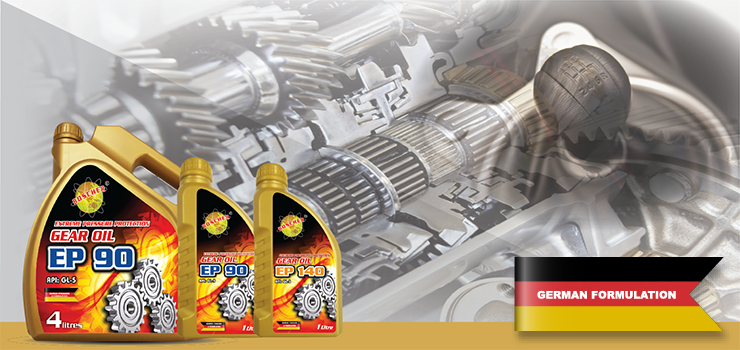
Gear Oil
 Most lubricants for manual gearboxes and differentials are hypoid gear oils. These contain extreme pressure (EP) additives and anti wear additives to cope with the sliding action of hypoid bevel gears.
Most lubricants for manual gearboxes and differentials are hypoid gear oils. These contain extreme pressure (EP) additives and anti wear additives to cope with the sliding action of hypoid bevel gears.
EP additives which contain phosphorous/sulfurous compounds are corrosive to yellow metals such as the copper and/or brass used in bushings and synchronizers; the GL1 class of gear oils does not contain any EP additives and thus finds usage in applications which contain parts made of yellow metals.
GL-5 is not necessarily backward-compatible in synchro-mesh transmissions which are designed for GL-4 oil: GL-5. It has a lower coefficient of friction due to the higher concentration of EP additives over GL-4, and thus synchros cannot engage effectively. Also, transmissions which explicitly call for GL-4 oil may have been designed around this lower concentration of EP additives and thus may contain yellow metal parts which GL-5 will corrode.
API classification subdivides all transmission oils into 6 classes:
- API GL-1. Oils for light conditions. They consist of base oils without additives. Sometimes they contain small amounts of antioxidizing additives, corrosion inhibitors, depressants and antifoam additives. API GL-1 oils contain no EP additives, are designed for spiral-bevel, worm gears and manual transmissions with synchronizers, in trucks and farming machines.
- API GL-2. Oils for moderate conditions. They contain anti-wear additives and are designed for worm gears. Recommended for proper lubrication of tractors and farming machinery transmissions.
- API GL-3. Oils for moderate conditions. Contain up to 2.7% anti-wear additives. Designed for lubricating bevel and other gears of truck transmissions. Not recommended for hypoid gears.
- API GL-4. Oils for various conditions -light to heavy. They contain up to 4.0% effective anti-scuffing additives. Designed for bevel and hypoid gears which have small displacement of axes, the gearboxes of trucks, and axle units. These oils are standard for synchronized gearboxes, especially in Europe, and may also be recommended for non-synchronized gearboxes of US trucks, tractors and buses and for main and other gears of all vehicles. GL-4 oils may also be used in many limited-slip differentials.
- API GL-5. Oils for severe conditions: They contain up to 6.5% effective anti-scuffing additives. The general application of oils in this class is for hypoid gears having significant displacement of axes, generally non limited-slip differentials. They are recommended as universal oils to all other units of mechanical transmission (except synchronized gearboxes specifying GL-4). Some GL-5 oils in this class, which have special approval of vehicle manufacturers, can be used in synchronized manual gearboxes. API GL-5 oils can be used in limited slip differentials only if they correspond to the requirements of specification MIL-L-2105D or ZF TE-ML-05. In this case the designation of class will be different, for example API GL-5+ or API GL-5 LS.
- API GL-6 is not applied any more as it is considered that class API GL-5 sufficiently meets the most severe and stringent requirements. When API GL-6 was still in use, it was noted that the oils were utilized under very heavy conditions (high speeds of sliding and significant shock loadings). They contained up to 10% high performance anti-scuffing additives. They were designed for hypoid gears with significant displacement of axes. However, in 2011 at least one company offered a new polyol ester based API GL-6 oil, mainly for racing applications. The application is limited to certain types of manual transmissions, but improvements in BSFC of about 5% in standard weather and driving conditions and up to 15-20% in cold extremes (arctic weather conditions) can be expected.

